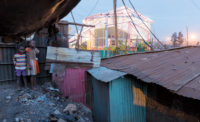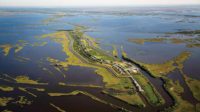In 1942, two U.S. Army soldiers arrived at the office of Skidmore, Owings & Merrill (SOM) with a request: the government wanted to hire the firm to build a city in complete secrecy. Within months, John Merrill was standing in the mountains of Tennessee, pacing out streets and buildings.
The resulting city, Oak Ridge, was one of three built from scratch to house technicians working on the Manhattan Project, the government’s top-secret initiative to develop the atomic bomb. In time, designing Oak Ridge would prove a watershed project for SOM, and the trio of towns, a milestone in the history of American urban planning.
A new exhibit opening today at the National Building Museum in Washington, D.C., explores the architectural significance of these Manhattan Project “secret cities.” Plans, photographs, and artifacts from each illuminate the routines of daily life within their borders, as well as the lasting impact of their architectural innovations.
“These citties were conceived as forward-looking places to raise families, and they went on to become proving grounds for big ideas about town planning,” said Martin Moller, the exhibit’s curator, whose father-in-law worked as a scientist at Oak Ridge. “You can see the hand of design even at the beginning of their existence.”
Despite the urgency of the Manhattan Project, SOM planned for residents to live not in large dormitories but rather in a prototypical suburb with single-family homes spaced out on grassy lawns. In the exhibit’s largest room, sketches and maps for Oak Ridge are displayed on a central table while photos on the walls show how the city was built. SOM designed prefab modernist houses and shipped them to Oak Ridge in boxes. (They also planned for segregated neighborhoods of small shacks for African American residents.)
On the other side of the country, Swedish architect G. Albin Pehrson designed another secret city: the town of Richland in southeastern Washington state. The community, comprised of colonial wood houses, was built twenty miles away from the reactors, both to give the feeling of a real “bedroom community” and to protect residents from potential plutonium detonation. In the still smaller town of Los Alamos, New Mexico, the army built fewer new buildings, mostly repurposing the Los Alamos Ranch School to house scientists and equipment.
During the war, almost no one in the towns knew what they were working on; the cities were totally fenced in and didn’t even appearon maps. Nevertheless, photos of workers eating lunch and attending ballroom dances on weekends show that they mostly lived normal lives.
“To me, a large part of what these cities have to teach us is in the organizational aspect,” said Moller. “How did they manage to achieve this? The secrecy wouldn’t be possible now, but architects today can learn from the scale and speed of the project.”
The exhibition concludes with an exploration of post-Hiroshima life in the three cities. In short films, former residents offer oral histories, reflecting decades later on their lives in the clandestine towns. Placards next to photos of demolished reactors explain the years-long clean-up process of the radioactive sites . But all three towns have since become thriving research centers, and current residents celebrate their unique heritage: a Richland High School t-shirt reveals that the school’s mascot is “the Bomber.” In 2015 Congress designated the towns part of the new Manhattan Project National Park, and their unique features will now be preserved as living examples of ambitious planning and design.
Secret Cities: The Architecture and Planning of the Manhattan Project runs through March 3, 2019 at the National Building Museum in Washington, D.C.












Post a comment to this article
Report Abusive Comment